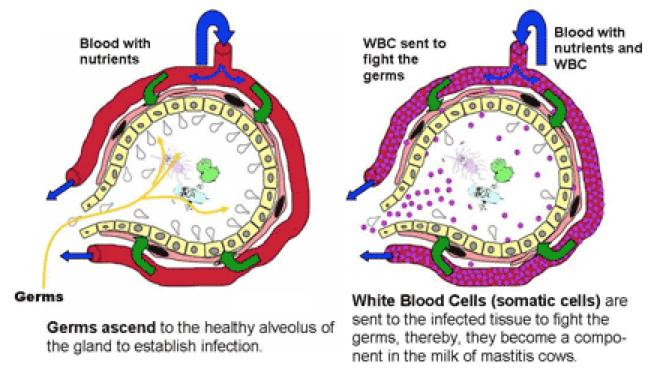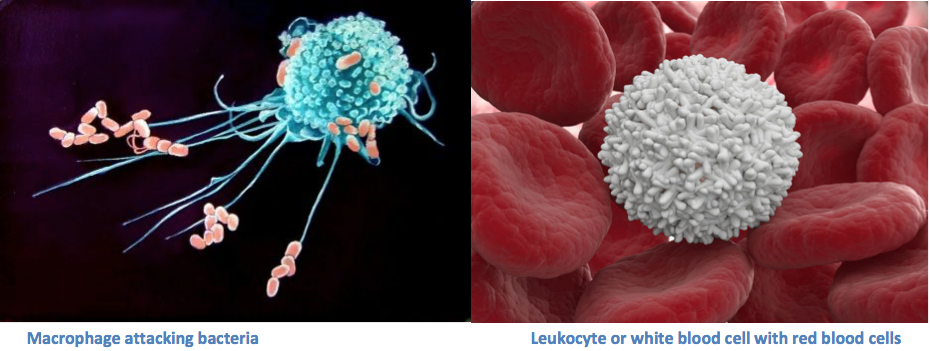As somatic cell count (SCC) standards are tightening, Arizona DHIA is receiving many inquiries from proactive managers and producers. Although we defer all herd health recommendations to dairy veterinary practitioners, Arizona DHIA provides all the necessary tools to achieve SCC reduction goals. This email provides a basic outline of UDA’s quality testing programs to clarify Arizona DHIA’s role as UDA’s third party testing lab and secondly, to outline long term, low SCC maintenance tools.
SOMATIC CELL COUNTS AND THE GLOBAL MARKET
Somatic cells are white blood cells (primarily macrophages and leukocytes,) secretory cells, and squamous cells. Every mammal secretes somatic cells with their milk. High somatic cell counts indicate inflammation in the mammary gland. The significance of BTSCC’s for the dairy industry is that there is an inverse relationship between BTSCC and cheese yield and shelf-life of fluid milk products. This reveals that as BTSCC’s increase, cheese yield and shelf life decrease. In addition, high BTSCC’s affect customer satisfaction. As somatic cells breakdown in fluid milk, cellular biochemicals are released into the milk and result in an off flavor. Although the bacterial content is significantly reduced with pasteurization, the milk will taste sour.

BTSCC requirements in the EU, Australia, and New Zealand are 400,000 cells/mL. Grade A fluid milk BTSCC is 750,000 cells/mL in the US (established in 1986 with the Public Milk Ordinance. Here’s the link if you’re interested in reading the current PMO: http://www.fda.gov/downloads/Food/GuidanceRegulation/UCM209789.pdf.) Missouri Business Update reported that, “in 2008 we were exporting 11% of the total US supply and today it is down to 7%… Increasing the export of dairy products will help reduce the surplus of milk in the US and increase domestic milk prices.” This is an enormous impetus for coops across the US to decrease BTSCC limits and reward low BTSCC herds, since some international standards for BTSCC’s are stricter. Coops and creameries that are trending towards stricter BTSCC numbers are simultaneously choosing to remain competitive in a global market and provide broader market potential for coop members.
LOCAL BACTERIOLOGY MONITORING
For UDA producers, “quality” week occurs on the first full week of the month and is the test panel that is most valuable in trouble shooting high BTSCC numbers. During quality week, one sample is selected from each producer. The tanks selected are randomly rotated through the year. This panel includes a bulk tank culture that provides a count breakdown of all bacterial groups, except Mycoplasma spp. Staph. aureus and Strep. ag. counts are included in this breakdown. The test panel also includes a standard plate count (total bacteria per milliliter,) lab pasteurization count, coliform count, preliminary incubation count, and a broth enhanced test for the presence of Mycoplasma spp. The presence of contagious pathogens in any herd will elevate BTSCC’s, so take note of these numbers.
In addition for UDA producers, “survey” samples are pulled in four cycles through the month. Survey samples are pulled from every producer, every tank, once per week. During the first full week of the month, any tanks not covered by the quality sample are pulled for survey analysis. The survey panel includes three tests: standard plate count, lab pasteurization count, and preliminary incubation count. The survey testing panel focuses on analysis for plant management purposes. Note, a high SPC coupled with high BTSCC indicates a serious mastitis issue.
LOW BTSCC MAINTENANCE
The common question asked these days is, “what can Arizona DHIA do to help us find high SCC cows, and how do we minimize the milk from high SCC cows from entering our tanks?”
We have many tools that can be customized in cost efficient ways to help clients with BTSCC concerns. In discussing the recent trend towards tightening SCC requirements, a local dairy vet practitioner recommended pulling milk samples from fresh pens only for SCC determination. This method of sampling provides a quick way to know which cows are entering the herd with elevated somatic cell counts. It is also an excellent way to determine the efficacy of dry cow therapies. Proactive managers suggest monitoring “tail-ender” pens. Arizona DHIA’s certified field technicians are available for monthly, whole herd sampling or sampling of single pens for somatic cell counts.
It is also recommended to submit milk cultures from all fresh heifers and cows. Cultures for mastitis pathogens from fresh cows permit the isolation and treatment of fresh cows with subclinical mastitis early in lactation, thus keeping high somatic cell count cows’ milk out of the bulk tank. A regular bulk tank culture through Arizona DHIA costs $6.75 per sample. A bulk tank can be monitored once a week for major mastitis pathogens for under $30 per month or $60 per month to include a broth enhanced Mycoplasma spp. test. The cost is nominal for the serious value a low SCC herd delivers through quality bonuses and incentives.
Ultra-pasteurization changed the fluid milk market forever. Products no longer have to be processed into cultured products like cheese and yogurt to guarantee freshness and quality in deliveries across the globe. Now, global quality standards have major impacts on local quality standards. Recent changes to local SCC quality programs demonstrate this fact. Use Arizona DHIA’s one-stop shop to serve your emerging needs. Contact us at (480) 894-0156 to schedule single pen sampling for SCC surveillance or to set up fresh cow cultures.
“There comes a moment when you have to stop revving up the car and shove it into gear.” –David Mahoney
